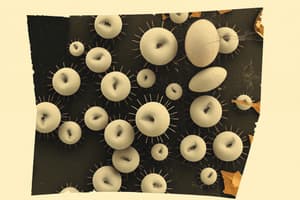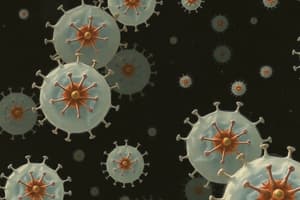Podcast
Questions and Answers
What primarily facilitates the first wave of immune response during inflammation?
What primarily facilitates the first wave of immune response during inflammation?
- Neutrophils (correct)
- Macrophages
- Lymphocytes
- Eosinophils
Which type of WBC is known for providing a rapid defense against infection?
Which type of WBC is known for providing a rapid defense against infection?
- Neutrophils (correct)
- Monocytes
- Lymphocytes
- Basophils
Where are lymphocytes predominantly formed and stored?
Where are lymphocytes predominantly formed and stored?
- Thymus and spleen only
- Bone marrow only
- Blood vessels
- Various lymphoid tissues (correct)
What is the term for the process by which leukocytes exit the bloodstream to enter tissue?
What is the term for the process by which leukocytes exit the bloodstream to enter tissue?
During inflammation, after neutrophils, which leukocyte type typically joins the immune response later?
During inflammation, after neutrophils, which leukocyte type typically joins the immune response later?
How many times more WBCs are stored in the bone marrow compared to those circulating in the blood?
How many times more WBCs are stored in the bone marrow compared to those circulating in the blood?
In what form do monocytes enter inflamed tissues?
In what form do monocytes enter inflamed tissues?
Which leukocytes are formed in the bone marrow but stored in lymphoid tissues?
Which leukocytes are formed in the bone marrow but stored in lymphoid tissues?
Which type of leukemia specifically affects the production of myeloid cells?
Which type of leukemia specifically affects the production of myeloid cells?
Which option refers to cancer cells primarily affecting lymphatic tissues over an extended period?
Which option refers to cancer cells primarily affecting lymphatic tissues over an extended period?
What type of macrophage is specifically found in the gut?
What type of macrophage is specifically found in the gut?
Which leukemia type is characterized by the cancerous production of young myelogenous cells?
Which leukemia type is characterized by the cancerous production of young myelogenous cells?
Which of the following is not a type of leukemia mentioned?
Which of the following is not a type of leukemia mentioned?
What is primarily displaced in the body as a result of leukemia?
What is primarily displaced in the body as a result of leukemia?
What drug is mentioned to potentially cause leukopenia?
What drug is mentioned to potentially cause leukopenia?
What effect does leukemia have on the body's nutritional resources?
What effect does leukemia have on the body's nutritional resources?
What is a significant consequence of the rapid reproduction of leukemic cells?
What is a significant consequence of the rapid reproduction of leukemic cells?
Which of the following compounds is used to treat thyrotoxicosis and is noted in relation to leukemia?
Which of the following compounds is used to treat thyrotoxicosis and is noted in relation to leukemia?
What happens to normal protein tissues in the body due to leukemia?
What happens to normal protein tissues in the body due to leukemia?
What leads to metabolic starvation in patients with leukemia?
What leads to metabolic starvation in patients with leukemia?
What type of cells proliferate abnormally in leukemia?
What type of cells proliferate abnormally in leukemia?
What is the primary role of the inflammatory process in the body?
What is the primary role of the inflammatory process in the body?
Which components make up the monocyte-macrophage cell system?
Which components make up the monocyte-macrophage cell system?
What triggers local vasodilation during an inflammatory response?
What triggers local vasodilation during an inflammatory response?
Chronic inflammation is defined as:
Chronic inflammation is defined as:
Where is the Reticuloendothelial system primarily located?
Where is the Reticuloendothelial system primarily located?
What consequence can occur if inflammation persists without a present threat?
What consequence can occur if inflammation persists without a present threat?
Which type of cells first act in response to injury during inflammation?
Which type of cells first act in response to injury during inflammation?
What distinguishes fixed tissue macrophages from mobile macrophages?
What distinguishes fixed tissue macrophages from mobile macrophages?
What is primarily responsible for recruiting leukocytes to an inflamed region?
What is primarily responsible for recruiting leukocytes to an inflamed region?
What role do platelets play in the inflammatory response?
What role do platelets play in the inflammatory response?
Which of the following is not a function of the reticuloendothelial system (R.E.S)?
Which of the following is not a function of the reticuloendothelial system (R.E.S)?
What effect does the 'walling off' process during inflammation have?
What effect does the 'walling off' process during inflammation have?
Which of the following statements about the inflammatory response is accurate?
Which of the following statements about the inflammatory response is accurate?
What is the initial action of the body to prevent pathogens from spreading through the blood?
What is the initial action of the body to prevent pathogens from spreading through the blood?
Which of the following components helps eliminate heparin from the body during inflammation?
Which of the following components helps eliminate heparin from the body during inflammation?
How does the inflammatory response facilitate tissue repair?
How does the inflammatory response facilitate tissue repair?
Flashcards are hidden until you start studying
Study Notes
White Blood Cells (WBCs)
- WBCs offer rapid and strong defense against infections.
- Lymphocytes are produced in lymphoid tissues like lymph glands, spleen, and thymus, as well as in bone marrow and Peyer’s patches in the gut.
- Bone marrow stores about three times more WBCs than those circulating in blood, providing a 6-day supply.
- Neutrophils initiate the inflammatory response by being the first cells to leave the bloodstream and enter inflamed tissues.
- Monocytes migrate to inflamed tissues and differentiate into macrophages.
Inflammatory Process
- Inflammation serves as a protective mechanism against pathogens, toxins, and injuries.
- Leukocyte extravasation (transmigration) involves the movement of WBCs from the bloodstream into tissues during inflammation.
- Chronic inflammation occurs when an inflammatory response persists despite the removal of threats.
Monocyte-Macrophage Cell System
- Comprised of monocytes, mobile and fixed macrophages, and specialized endothelial cells in tissues like bone marrow, spleen, and lymph nodes; known as the Reticuloendothelial System (RES).
- Functions include removing foreign objects and toxins, forming new blood cells, and clearing waste materials.
Characteristics of Inflammation
- Inflammation creates a "walling off" effect to isolate the injury, preventing the spread of bacteria and toxins through fibrinogen clots.
- Local vasodilation and increased capillary permeability are caused by histamine release from mast cells during inflammation.
Impact of Leukemia
- Characterized by high counts of abnormal WBCs and hampers the production of functional leukocytes.
- Leukemic cells produce rapidly, leading to increased demand for nutrients and energy depletion in the body.
- Types of leukemia include Acute Myelogenous Leukemia, Chronic Myelogenous Leukemia, Acute Lymphocytic Leukemia, and Chronic Lymphocytic Leukemia.
Types of Macrophages
- Various specific types of macrophages exist, such as microglia (in the CNS), intestinal macrophages, histiocytes, and alveolar macrophages (in the lungs).
Studying That Suits You
Use AI to generate personalized quizzes and flashcards to suit your learning preferences.




